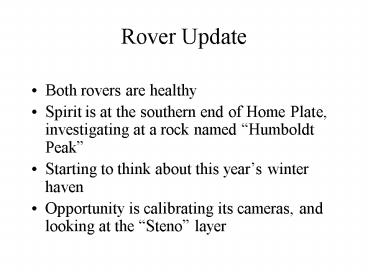Rover Update PowerPoint PPT Presentation
1 / 28
Title: Rover Update
1
Rover Update
- Both rovers are healthy
- Spirit is at the southern end of Home Plate,
investigating at a rock named Humboldt Peak - Starting to think about this years winter haven
- Opportunity is calibrating its cameras, and
looking at the Steno layer
2
Rocks at Southern End of Home Plate Humboldt_Peak
3
Geographic Feature Names
Fracture?
120 m
Next Target
4
Steno (née a)
?
Smith (née b)
?
Lyell (née g)
Layers renamed Nicholas Steno (1638-1686)
http//en.wikipedia.org/wiki/Nicolas_Steno William
Smith (1769-1839) http//en.wikipedia.org/wiki/Wi
lliam_Smith_(geologist) Charles Lyell (1797-1875)
http//en.wikipedia.org/wiki/Charles_Lyell
5
2nd Steno target (behind)
Steno
Sol 1313 FHaz
6
Field Trip!
In the Shadow of the Moon -- an oral history of
the Apollo program Just from the distance of
the moon, you can hide the Earth behind your
thumb, everything that you have ever known your
loved ones, your business, the problems of the
Earth itself, all behind your thumb. It makes you
consider how insignificant we really are. --
James Lovell
- Voted best documentary at the Sundance Film
Festival - Playing at Cinemapolis until October 18th
7
From last time
- Martian year 687 days (669 sols)
- The heliopause is around 100-200 AU from the sun
- Voyager I has passed the termination shock, where
the solar wind speed drops from supersonic to
subsonic Voyager II is seeing the first signs of
the shock. They should get to the heliopause in
10-20 years - Before the heliopause most particles are
electrons and protons - ISM most particles are hydrogen and helium atoms
Reference http//voyager.jpl.nasa.gov/mission/int
erstellar.html
8
Mars Global Surveyor (MGS)Science Results
- Astro 280
- October 10, 2007
9
Mission Overview
- Launched on November 7, 1996
- Arrived on September 11, 1997
- Aerobraked until March 9, 1999
- Communication ended in November 2006
http//nssdc.gsfc.nasa.gov/planetary/image/mars_gl
obal_surveyor.jpg
10
Highlights
- First spacecraft to use aerobraking to
circularize its orbit around Mars - Operated longer than any other spacecraft at Mars
- Sent more than 240,000 images back to Earth
- Observed annual weather cycles
- Produced a global topographical map of Mars
- Found evidence of the mineral hematite
- Found evidence of an ancient magnetic field
- Found evidence of modern-day sudden erosion
11
Instrument Overview
- Mars Orbiter Camera (MOC)
- Mars Orbiter Laser Altimeter (MOLA)
- Thermal Emission Spectrometer (TES)
- Magnetometer/Electron Reflectometer (MAG/ER)
- Ultrastable Oscillator for Radio Science
experiments - Mars Relay
12
MOC
- First high-resolution camera in Mars orbit (up to
1.5 m per pixel) - Found evidence of ancient river deltas, layered
sediments, and geologically young gullies - Compiled a global mosaic (7.5 km/pixel) every 24
hours
http//www.msss.com/mars_images/moc/may_2000/n_pol
e/ Image credit NASA/JPL/MSSS
13
Evidence of Ancient Water/Sediment Flow
http//www.msss.com/msss_images/2007/04/13/
Image credit NASA/JPL/MSSS
14
New Gullies!
http//www.nasa.gov/mission_pages/mars/images/pia0
9027.html Image credit NASA/JPL/Malin Space
Science Systems
- A gully appeared in Terra Sirenum between
December 2001 (left) and April 2005 (right) - Might be due to water, but not necessarily
15
Other cool pictures
http//www.msss.com/mars_images/moc/2005/05/19/ Im
age credit NASA/JPL/M SSS
http//mars.jpl.nasa.gov/mgs/sci/earth/index.html
Image credit NASA/JPL/M SSS
Earth
Mars Odyssey
16
Hearts and Rippled Fog
From http//www.msss.com/mars_images/moc/2004/02/1
4/ Image credit NASA/JPL/M SSS
From http//www.msss.com/mars_images/moc/2003/07/1
7/ Image credit NASA/JPL/M SSS
17
The Face on Mars
From http//www.msss.com/mars_images/moc/extended_
may2001/face/ Image credit NASA/JPL/M SSS
18
Surface Features
From http//www.msss.com/mars_images/moc/2005/02/0
2/
From http//www.msss.com/mars_images/moc/2004/07/2
5/
From http//www.msss.com/mars_images/moc/2006/09/1
2/
Image credit NASA/JPL/M SSS
19
Rover Tracks!
From http//www.msss.com/mars_images/moc/2004/09/2
7/ Image credit NASA/JPL/M SSS
20
MOLA
N
S
http//ltpwww.gsfc.nasa.gov/tharsis/mola.html
Image credit MOLA Science Team
- First high-resolution global topographical map of
Mars - Used a 1.064 ?m (IR) laser pulse
- 1 spatial resolution (59 km at equator), 13 m
accuracy - Also measured albedo and ice clouds
21
http//ssed.gsfc.nasa.gov/tharsis/map_lab.html
Image credit MOLA Science Team
22
MOLA Results
- The south pole is about 6 km higher than the
north pole! - The surface of the southern hemisphere is rougher
than the northern lowlands - Hellas basin is the deepest place on Mars -- 9km
from crater rim to bottom - The polar caps contain at most enough water to
cover Mars about 22-33 m deep (less than people
thought)
23
TES
- Used IR spectroscopy to map the minerals on the
martian surface - Continuously monitored the atmosphere for several
martian years - Discovered hematite in Meridiani Planum
From http//tes.asu.edu/discoveries/1/index.html I
mage credit NASA/JPL/Arizona State University
24
TES Results
- Most of the martian surface is made up of igneous
rocks, which are as diverse as Earths - Mars has minerals that (on Earth) only form in
water - When the atmosphere gets dusty, water-ice clouds
disappear for months - The polar caps are water-ice, seasonally covered
by CO2
25
MAG/ER
Mitchell et al., Journal of Geophysical Research,
Vol.112, E01002, doi10.1029/2005JE002564 , 09
January 2007
- Compiled a global map of the magnetic fields in
the martian crust, with a sensitivity of 10 nT
(Earths magnetic field is about 5 x 10-5 T
50,000 nT)
26
MAG/ER Results
- Mars does not currently have a global magnetic
field - It used to the older areas of the surface
exhibit magnetic anomalies - The magnetic field flipped like Earths does, but
either it flipped less often or the surface
spread faster (or both) - The magnetic field (mostly) disappeared before
the surface of the northern plains formed
27
Radio Science
http//mars.jpl.nasa.gov/mgs/sci/mola/mar10-2000/i
nternal_paper.html Image credit MGS RS and MOLA
Science Teams
- Monitored atmospheric temperature and pressure
variations for several martian years - Used Doppler shifts to precisely measure the
gravitational field
28
Mars Weather Maps
http//www-star.stanford.edu/projects/mgs/high/hig
hlight06.html

